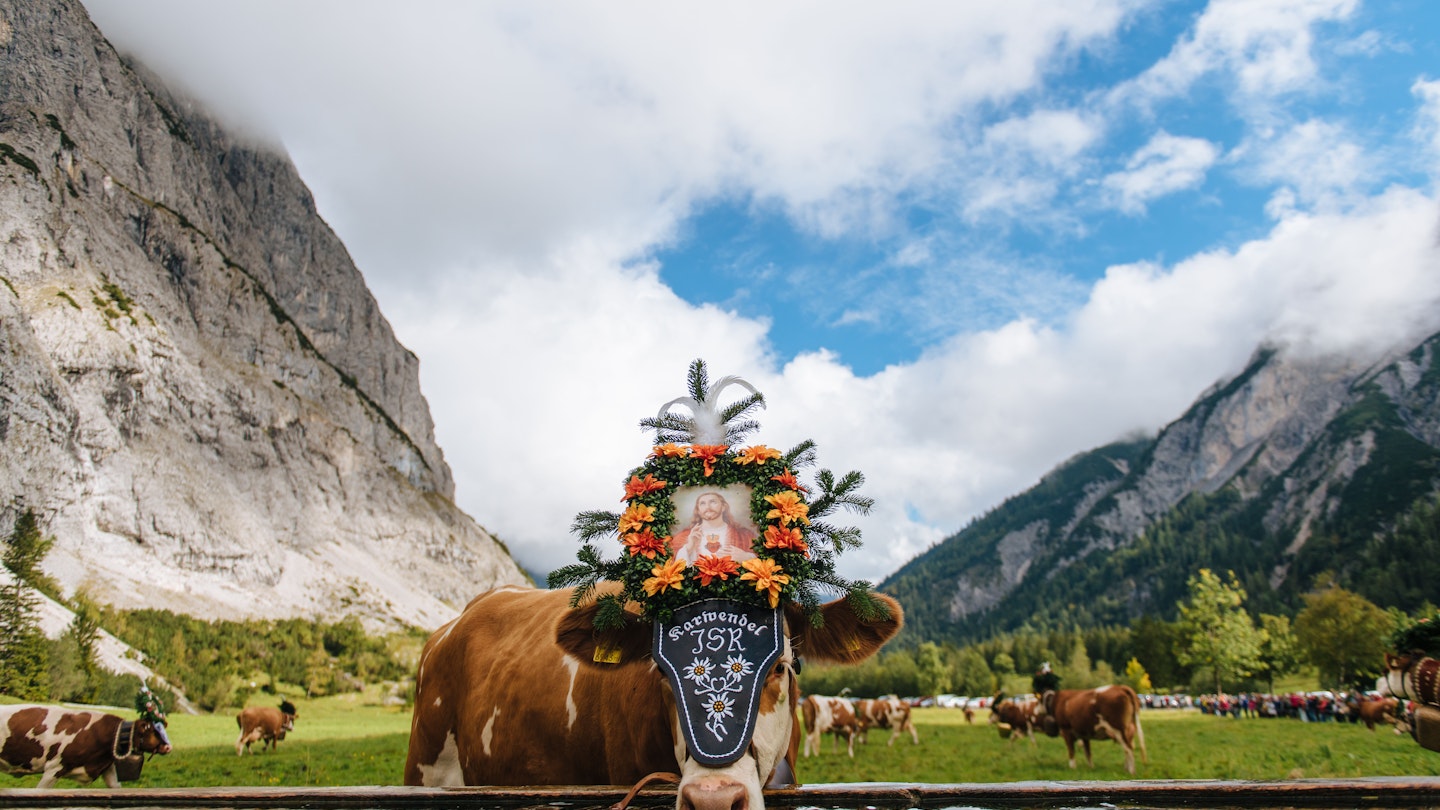The Almabtrieb is both a prized tradition among Alpine farmers and a well-loved spectacle among tourists. However, climate change and shifting economics are contributing to an uncertain future.
It was a typical scene in the town of Pertisau, up in the Austrian Alps: a herd of brown-and-white cows meandered across a pasture, tendrils of fog hugging the rocky peaks towering above them.
This chilly Friday in mid-September was not a normal day at Gramai Alm, a hotel high in the Austrian mountain province of Tyrol. The 45 cows were dressed up for a special occasion, sporting heavy metal bells on embroidered leather straps and elaborate, flower-adorned headdresses on their bobbing heads. Hundreds of people had gathered, eager to see them as if they were celebrities on a red carpet.
Onlookers called to individual cows, hoping they might pause or turn towards them long enough for a photo. The cows, however, were far more intent on grazing lazily on bright tufts of grass, wandering slowly back and forth across the meadow.
A Cattle Drive, but Make It Fancy
Across the Austrian and German Alps, cattle drives known as Almabtrieb have been part of local tradition for centuries. The concept is simple: cows spend the warm months, from late spring into early fall, grazing in the high mountain pastures. When the weather starts to turn cold again, towns organize events to bring the cows back down the mountain into the stalls and farms where they will spend the winter. This tradition marks the end of summer and honors the significant role that agriculture, and cows specifically, play in Alpine towns.
Tourists and locals alike gather to watch the cows being decorated and to follow them along their path into town. At the end, there’s always a celebration, featuring traditional Austrian delicacies like schnitzel, roast pork, and frittatensuppe, a soup with thin pancake strips.
The ceremony serves as a window into Alpine culture in a part of the world where tradition – sometimes hyper-local – is deeply rooted. Each town has its unique take on the event, with different decorations for the cows and a slightly different structure to the day’s activities.
With the stunning mountains providing the backdrop, the cows adorned with headdresses represent a cherished aspect of rural life. However, Almabtrieb events face unprecedented challenges due to climate change and evolving economic pressures. The grazing cows are essential in maintaining the picturesque Alpine landscapes, complete with closely trimmed meadows and trails that attract tourists. Nonetheless, the way of life for Alpine farmers becomes increasingly untenable amid these changes.
An Uncertain Future
In Pertisau, the tradition is relatively young compared to other Alpine regions. The Rieser family, who own around 120 cows, first started organizing the event in 1960, initially as a small community celebration. Over the years, it has increasingly drawn tourists.
The evening before the big cattle run, Sepp Rieser shared that he attended the first local Almabtrieb as a young boy. Now in charge, he leads the cattle down through the valley to Pertisau and beyond, wearing traditional attire.
Across the Alps, farmers face increasingly tough odds to sustain their businesses. Globalization and climate change complicate the operations of family-run farms. Warmer temperatures are reshaping Alpine landscapes, melting glaciers, and altering the flora. Additionally, young people are seeking more lucrative opportunities, often leaving behind small-scale agriculture. Sepp Rieser remarked that running a farm today requires hard work and a substantial dose of optimism.
“One must possess a deep love for farming; it cannot be solely about the financial gain,” he expressed. “It’s disheartening, yet we continue with immense passion.”
Tradition for Some, Destination for Others
Pertisau is well-positioned to benefit from events like the Almabtrieb, thanks to its historical significance as the summer residence of Kaiser Maximilian I. The town’s appeal to tourists has helped foster a robust tourism industry.
Even as new businesses cater to hikers and vacationers, the essence of the community remains unchanged. The Gramai Alm’s charming, traditional decor evokes a sense of nostalgia.
This dedication to tradition captivates visitors who come to witness the Almabtrieb. On the big day, crowds arrive by car, bicycle, and tour bus. As cows sauntered into the meadow, their bells chimed rhythmically against the ambient chatter. Much of the audience consisted of Germans and Austrians, perhaps in search of a glimpse into the traditional rural lifestyle they no longer live daily.
“We have cows, but we don’t have Almabtrieb,” Pamela, a visitor from Thuringia, excitedly noted while attending the event with her mother.
For Now, The Bells Still Ring
Once fully adorned, the cattle drive commenced. Young men with herding sticks coordinated the cows, encouraging them to trot down the valley. Observers lined the route, while others followed on bikes or foot.
As the procession progressed, the sound of jingling bells grew louder against the stunning mountain backdrop. A farmer on horseback led the way as the young farmhands ensured the cows stayed grouped together through the streets lined with spectators. Maria Cavins, an American from Virginia, expressed her excitement, sharing that her love for living near the Alps had drawn her to experience this cherished event.
As the cows continued after the celebration, many visitors returned home, filled with memories of the treasured Almabtrieb tradition. With each passing year, the tradition reminds the community of its deep cultural roots and the essential bond between agriculture and Alpine life.





